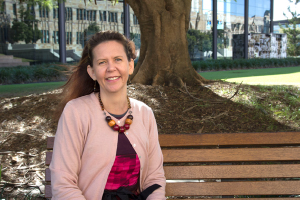Pain is an unpleasant sensory and emotional experience. Doctors group pain into two types: acute and chronic.
Acute pain lasts for a short time and usually results from an injury or an operation. It is the body’s warning sign that help is needed.
Chronic pain lasts beyond the normal time it takes the body to heal. It has many causes, including cancer, chemotherapy drugs, diabetes, nerve damage, and severe injuries such as burns. Some people also experience chronic pain without a direct cause, and chronic pain is now becoming recognised as a disease in its own right.
At the IMB Centre for Pain Research, our aim is to understand the mechanisms underlying the origins and transmission of pain, and to use this knowledge to produce more effective analgesics and improve quality of life for the increasing number of Australians living with pain. Much of this work is done by harnessing biochemical components of animal venoms.
Burden of chronic pain
One in five Australians, and one in three Australians over the age of 65, suffers from chronic pain, which remains one of the most under-recognised and under-treated medical problems.
The economic cost of treating chronic pain in Australia exceeds $34 billion per year, which is more than the cost of treating cancer, stroke, and diabetes. Many types of chronic pain (e.g. neuropathic pain) are poorly treated by current-generation analgesics (‘painkillers’) due to lack of efficacy and/or dose-limiting side effects. New classes of analgesics are required to better manage the complex conditions of acute and chronic pain.
Burns - acute pain
Burns pain is an injury to the skin or other organic tissue, which is primarily caused by heat, radiation, radioactivity, electricity, friction or contact with chemicals.
Young children have had the highest rates of hospital admission due to burns in Australia in recent years (1999–00 to 2003–04).
The Australian Institute of Health and Welfare (2004) estimated that the cost to hospitals due to admitted cases of burn and scald injuries in Australia for the single year 1999–00 was $40.2 million, and for 2001–02 was about $38.7 million.
Fast facts about chronic pain
- 1 in 5 Australians suffer from chronic pain
- 28% of Australians have arthritis or other musculoskeletal conditions. That’s around 6.1 million people
- $34 billion is the estimated annual cost of treating chronic pain in Australia
- 10 IMB Centre for Pain Research scientists dedicated to investigating pain treatments
- 14% of Australians (3 million people) are affected by back problems, followed by 8% with osteoarthritis (1.8 million people), 3% with osteoporosis (728,00 people) and 2% with rheumatoid arthritis (445,00 people).
- Injury is the most common cause of chronic pain (38%)
Source: The Australian Institute of Health and Welfare, BUPA Australia.
Living with chronic pain - Kristine's and Susanne's stories
 Kristine has lived with chronic pain since a near-fatal motorcycle accident in 2008.
Kristine has lived with chronic pain since a near-fatal motorcycle accident in 2008.
“Chronic pain isn’t like other diseases — there are no visible symptoms and it’s hard to measure, which makes treatment a constant challenge.
The pain research happening here in Queensland is very exciting and could offer new and improved ways to help me manage my pain in the near future.”
Susanne is a local Gordon Park resident who has had long-term chronic pain, and is passionate about increasing awareness of chronic pain in the community.
“I have worked for years in hospitality, but I just can’t do it anymore,” Susanne said.
“I would wake up with more pain than when I went to bed – that’s when you know something is wrong,” she said.
Susanne has both osteoarthritis, and neuropathic pain as a result of previous surgery to remove cancer. She is currently on several medications, but still finds managing her pain difficult.
“I have good days and bad days – it’s a constant battle to find something that works for me. The problem is, some of the painkillers prescribed also worsen depression in patients. Chronic pain sufferers can also be diagnosed with debilitating depression. We don’t want to take a drug that helps with pain but makes us seriously depressed, but unfortunately there aren’t currently many options for us”.
In addition, the costs of the medications, physiotherapy, and acupuncture to manage Susanne's pain are an ongoing concern.
“I often have to wait until I can afford to buy the medications I need,” she said.
“Raising awareness about chronic pain and increasing care for those who suffer, like myself, is so important."
Resources and Links
For more information about living with chronic pain, and peer support, visit: Chronic Pain Australia
Other useful resources can be found at:
